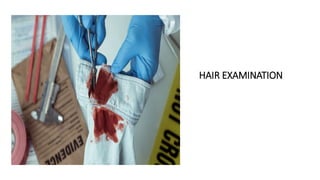
FORENSIC SEROLOGY_Unit2 _Hair examination.pptx
- 2. Forensic Significance One of the most often recovered types of evidence Hairs make good forensic evidence because they are sturdy and can survive for many years they carry a lot of biological information and they are easy and cost-effective to examine. DNA can also be extracted from hairs, and this adds to their forensic utility. Nonhuman or animal hairs are also potentially useful evidence, given the number of domestic animals kept as pets HUMAN HAIR WITH EPITHELIUM CELLS AT ROOT ANIMAL HAIR
- 3. Source: Houck 2015 Hairs are a particular structure common only to mammals; they are the fibrous growths that originate from their skin epidermis. The follicle is the structure within which hairs grow; it is a roughly cylindrical tube with a larger pit at the bottom. Hairs grow from the base of the follicle upward. In the base of the follicle, the hair is still very soft; as the hair proceeds up the follicle, it slowly begins to harden and dry out. Hair is made of keratin, a tough protein-based material from which hair, nails, and horns are made in animals. The hardening process of hair growth is therefore called keratinization. The follicle contains other structures, such as blood vessels, nerves, and sebaceous glands, the latter producing oils that coat hairs, helping to keep them soft and pliable. Hairs even have muscles, called pili arrector muscles
- 4. In the anagen, or actively growing, phase, the follicle produces new cells and pushes them up the hair shaft as they become incorporated into the structure of the hair. Melanocytes Specialized cells in the follicle produce small colored granules, called melanin (a dark brown pigment called eumelanin and a lighter pigment called pheomelanin).. After the active growth phase, the hair transitions into a resting phase; this transitional phase is called the catagen phase. the follicle begins to shut down production of cells, the cells begin to shrink, and the root condenses into a bulb-shaped structure called a root bulb or a club root. The telogen phase is the resting phase for the follicle. Cell production has ceased completely; When this mechanical connection breaks (through combing, brushing, or normal wear), the follicle is triggered into the anagen phase again and the cycle renews. 80–90% in the anagen phase, about 2% in the catagen phase, and about 10–18% in the telogen phase Source: Houck 2015
- 6. MICROANATOMY Source: Houck 2015 The root (located proximal ) is that portion that formerly was in the follicle, The shaft is the main portion of the hair. The tip is the distal most portion of the hair. Internally. The three main structural elements in a hair are the cuticle (a series of overlapping layers of scales), the cortex ( Fusiforms cells, pigment granules, cortical fusi), and the medulla.
- 10. General Descriptions of Human Body Area Hair Traits Area Diameter Shaft Tip Head Even Straight or curly some waviness; may be very long Usually cut Pubic Varies Buckling; sometimes extreme waviness or curl Usually pointed may be razor cut Facial Wide; even Triangular in cross section some shouldering Usually cut; may be scissors or razor cut Chest Even to some variation Wavy to curly; some more straight Usually pointed Axillary Even; some variation Less wavy/curly than chest Usually pointed; may be colorless Limb Fine; tapering Slight arc Usually pointed Eyebrow /eyelash Tapering Arc; short Pointed
- 11. SOURCE: FBI ARCHIVES Color treatment hair
- 12. Ancestry Diameter (μm) Cross Section Pigment Distributio n Cuticle Undulation African 60–90 Flat Dense; clumped Thin Prevalent European 70–100 Oval Even Medium Uncommon Asian 90–120 Round Dense to very dense Thick Never SOURCE: FBI ARCHIVES
- 13. Age and Sex The hairs of infants, for example, are generally finer and less distinctive in microscopic appearance. As individuals age, hair can undergo pigment loss and changes in the configuration of the hair shaft to become much finer and more variable in diameter. Although the sex of an individual is difficult to determine from microscopic examination, longer, treated hairs are more frequently encountered in female individuals. Sex can be determined from a forcibly removed hair (with tissue), but this is not routinely done. Definitive determination of sex can be accomplished through the staining of sex chromatin in the cells found in the follicular tissue nuclear DNA and mitochondrial DNA (mtDNA) tests will provide more specific information regarding the possible origin of the hair.
Editor's Notes
- Hairs that do not fit into these categories may be called transitional body hairs, such as those on the stomach, between the chest and the pubic region.